skin cancer
now browsing by tag
How to Make Your Own Suncreen!
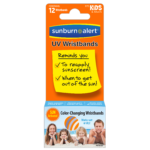
(This blog was revised on 6/14/16)
Be smart and stay away from TOXIC sunscreen
Scared to put that nasty, chemical sunscreen on your body, or even worse, your children’s skin? There is good reason. It’s is full of disgusting chemicals. If you read the label you will see scary ingredients like:
- Cinnamates
- OMC (Octyl Methoxycinnamate)
- Ethylhexyl p-Methoxycinnamate
- Salicylates
- OCS (Octyl Salicytate)
- Homomenthyl Salicylate
- Triethanolamine
- PABA (Para Aminobenzoic Acid)
- Padimate O
- Padimate A
- Glyceryl Aminobenzoate
- Octyl Dimethyl Paba
- Octocrylene
- Zinc Oxide
- Titanium Oxide
The ingredients that are used to absorb UVA radiation include:
- Benzoophenones
- Oxybenzone
- Dioxybenzone
- Avobenzone
Bleak! Just what you don’t want circulating in your blood. Your skin is your largest organ and acts like a sponge. Anything you put on your skin is going right into your body. If you don’t want to put it in your mouth, or eat it, then you don’t want to put it on your skin. Period!
Below here is a recipe for making your own sunscreen. (Another simpler way is to take the powdered zinc and pour it into your favorite lotion.)
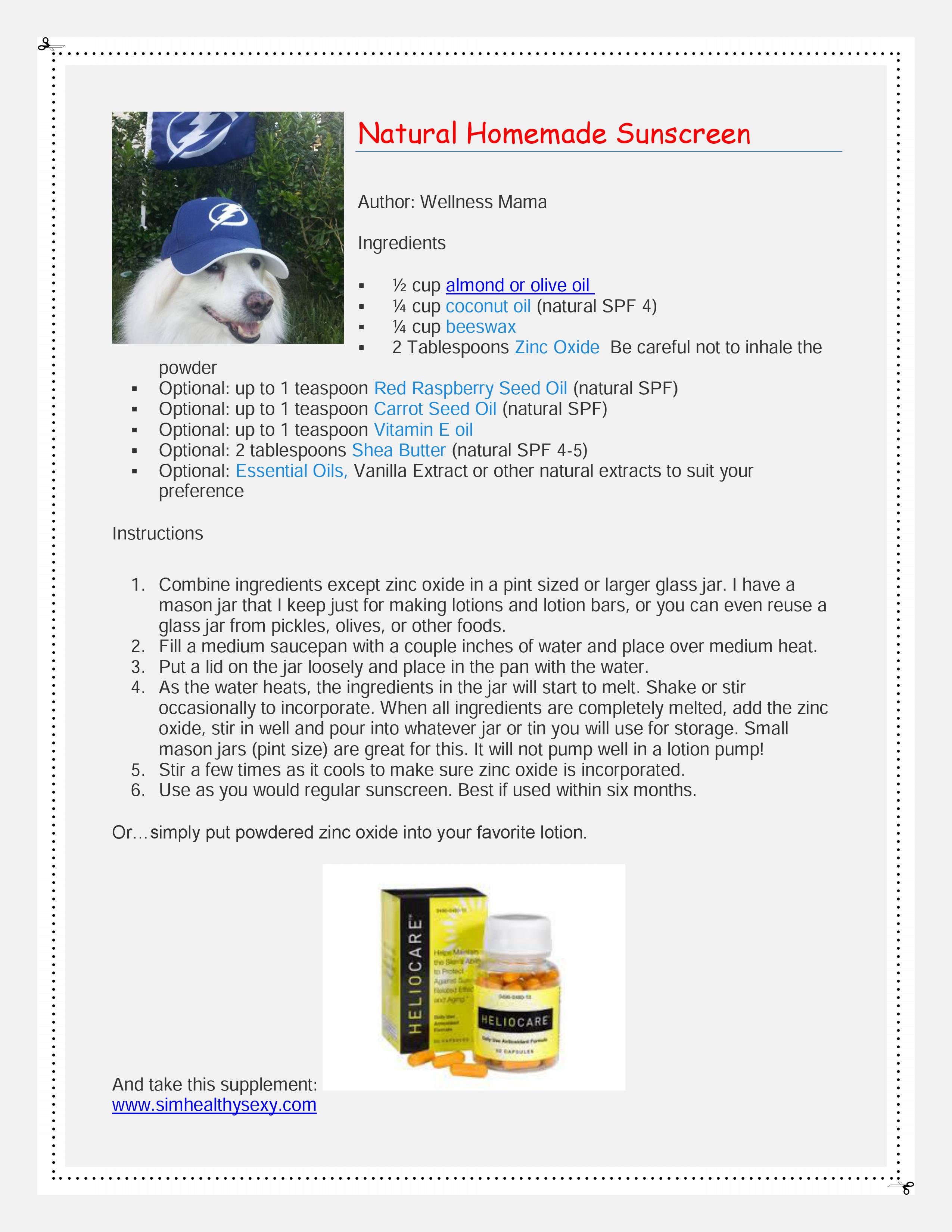 (If you want me to send you the above recipe as a PDF, just email me at admin@slimhealthysexy.com)
(If you want me to send you the above recipe as a PDF, just email me at admin@slimhealthysexy.com)
Here are some more ideas to protect your skin from the sun and acts as a natural sunscreen:
An umbrella! People have used one for years as a great way to protect their skin. I see in a lot of old, turn of the century photos where woman and men are holding umbrellas over their head on an obviously bright, sunny day. Why has this perfectly wonderful natural sunscreen fallen out of favor?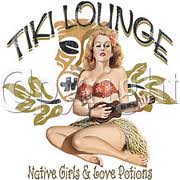
Well, I’m here to bring it back. Here are a few examples of great sun-blocking umbrellas:
Hats…good thing to use!
Here is a recipe for making your own sunscreen. (Another simpler way is to take the powdered zinc and pour it into your favorite lotion.)
Natural Homemade Sunscreen
Author: Wellness Mama
Ingredients
½ cup almond or olive oil
¼ cup coconut oil (natural SPF 4)
¼ cup beeswax
2 Tablespoons Zinc Oxide Be careful not to inhale the powder
Optional: up to 1 teaspoon Red Raspberry Seed Oil (natural SPF)
Optional: up to 1 teaspoon Carrot Seed Oil (natural SPF)
Optional: up to 1 teaspoon Vitamin E oil
Optional: 2 tablespoons Shea Butter (natural SPF 4-5)
Optional: Essential Oils, Vanilla Extract or other natural extracts to suit your preference
Instructions
1. Combine ingredients except zinc oxide in a pint sized or larger glass jar. I have a mason jar that I keep just for making lotions and lotion bars, or you can even reuse a glass jar from pickles, olives, or other foods.
2. Fill a medium saucepan with a couple inches of water and place over medium heat.
3. Put a lid on the jar loosely and place in the pan with the water.
4. As the water heats, the ingredients in the jar will start to melt. Shake or stir occasionally to incorporate. When all ingredients are completely melted, add the zinc oxide, stir in well and pour into whatever jar or tin you will use for storage. Small mason jars (pint size) are great for this. It will not pump well in a lotion pump!
5. Stir a few times as it cools to make sure zinc oxide is incorporated.
6. Use as you would regular sunscreen. Best if used within six months.
Or…simply put powdered zinc oxide into your favorite lotion.
What foods should you eat that provides natural sun protection?
Foods to Avoid
- processed foods
- vegetable oils (this is the most important for sun exposure)
- grains
- sugars
Foods to Eat
- lots of healthy saturated fats
- lots of foods rich in omega-3s (fish, etc)
- lots of leafy greens
- 2+ tablespoons of tomato paste daily
Supplements
You can also start taking a specific regimen of supplements that help reduce inflammation and improve sun tolerance. The supplements to take are:
- Vitamin D3 (I take about 5,000 IU/day)- Emerging evidence shows that optimizing blood levels of Vitamin D can have a protective effect against sunburn and skin cancer
- Vitamin C (I take about 2,000 mg/day)- A potent antiinflammatory, and it is good for the immune system too.
- 1/4 cup coconut oil melted in a cup of herbal tea per day- the Medium Chain Fatty Acids and saturated fat are easily utilized by the body for new skin formation and are protective against burning
- Fermented Cod Liver Oil/High Vitamin Butter Oil Blend (also great for remineralizing teeth)-Probably the most important supplement for sun protection. I take double doses during the summer and the kids take it too. Since adding this and the coconut oil daily, non

Wahhh my mommy just put sunscreen on me!
e of us have burned. It’s also great for digestive and oral health. (Amazon finally has the capsules back in stock)
- Astaxanthin– A highly potent antioxidant which research shows acts as an internal sunscreen. It’s also supposedly an anti-aging supplement. I wouldn’t give this one to the kids though.
(Good article: http://wellnessmama.com/4621/eat-your-sunscreen/)
Did you know pets can get melanoma? Here is a picture of my mother’s cat, Hanzie. (He passed away yesterday.)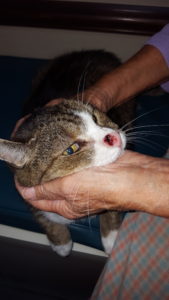
The North East Independent School District in San Antonio, Texas, considers sunscreen a toxic substance and, therefore, forbids students from bringing sunscreen to school or on field trips unless a doctor’s note is provided.
What is commercial sunscreen doing to the reefs?
Sunscreen is destroying the ocean reefs. A beach in Hawaii has banned sunscreen.
NOAA National Centers for Coastal Ocean Science researchers and their partners have discovered that a sunscreen chemical commonly used in many soaps, cosmetics, and body fragrances is highly toxic to corals. The team’s data show that even very low concentrations of benzophenone-2, or BP-2, can quickly kill juvenile corals. BP-2 is an additive used in personal-care products since the 1960s to protect against the damaging effects of ultraviolet light.
Has the use of sunscreen decreased skin cancer?
Contrary to popular belief, using sunscreen will increase your risk of melanoma. Sunscreen ingredients inhibit inducible nitric oxide synthase (iNOS). Sunscreens prevent UV-induced redness, which occurs in part through the action of nitric oxide (NO), synthesized in the skin. But NO is an important immunoregulatory molecule, and it is crucial in the induction of the cell-mediated tumor immune response.
According to an article in Melanoma Research:
“These findings suggest that sunscreens may prevent redness partly by UV absorption and partly by inhibition of the skin’s inflammatory response. As such, sunscreens might promote instead of protect against melanoma.”
Nitric oxide also acts to help lower your blood pressure — another reasons to avoid sunscreens that destroy the chemical in your body.
Sources:
Melanoma Research February 2005; 15(1): 3-6
Nitric Oxide February 15, 2010; 22(2): 136-140
Certain sunscreens in water under ultraviolet light can increase the production of hydrogen peroxide, which damages phytoplankton. Nanoparticles of titanium dioxide, an ingredient in some sunscreens, can accumulate in coastal waters and be ingested by marine animals.
And of course, as part of the natural sunscreen protection, children and adults should wear long sleeves shirts and shorts for added coverage even while in the water.
Help From Technology
Because you’re probably taking your phone to the beach, you could rely on it, instead of your faulty memory, to remind you to head under the umbrella or go inside. Android and iOS are rife with free and inexpensive apps that could alert you when you need it.
You could also seek help from wearables. A jewel-like device called JUNE, which can be worn as a bracelet or a brooch, monitors sun exposure and syncs with an iOS app that can tell you how quickly you’re using up your recommended sun allowance for the day.
Here are wristbands you can purchase that lets you know when you have exceeded your sun tolerance.
I hope this blog helps you deal with the sun.Thanks for reading!
With love,

Terry and Lucky
Terry Ryan, Blogger
The Skinny on Skin! by Terry Ryan
They have been warning us for years…the skin police. Don’t go outside without SPF50 on your skin. Blah, blah, blah. Where were they when I was pouring iodine into the baby oil and slathering it on my body to enhance the perfect burn? Nowhere, that’s were they were. Now I look at the skin of my peers who all used to lay on the Million Dollar Beach and burn until our skin peeled off in sheets. Some of them are wrinkled and some not so wrinkled. Hey, they said we would be wrinkled, old prunes by the time we turned 60. As I now gaze into the gorgeous tanned skin of one of my BFF’s whose lazy, summer days are spend floating around her pool with absolutely no sunscreen on I say “ha!” to all the experts.
What I am most happy about is that my generation was not berated into using mass quantities of sunscreen with god knows what ingredients. Yikes! I personally am more afraid of slathering chemicals on my skin than sitting out in the sun. However, I don’t sit out in the sun anymore because I believe pale is the new tan. Yeah, you heard me. I like not having tan lines.
Last year I went to my husband’s dermatologist for an itchy spot on my shoulder which proved to be  harmless and she called it something I can’t even repeat. She did say, “You have amazing skin.” So, here we are, two different specimens who have great skin: me and my BFF sunning in the pool. What separates us from the rest of the population who have not so nice skin? Is it genes alone or did we do something different way back then?
harmless and she called it something I can’t even repeat. She did say, “You have amazing skin.” So, here we are, two different specimens who have great skin: me and my BFF sunning in the pool. What separates us from the rest of the population who have not so nice skin? Is it genes alone or did we do something different way back then?
In spite of drug store shelves lined with sunscreen products, skin cancer is on the rise. (Here is a good place to look up the facts. http://www.skincancer.org/skin-cancer-information/skin-cancer-facts) When I was in high school and college, nobody ever died from skin cancer. Now, I hear sad stories of friends of friends or their relatives dying from skin cancer, mostly the dreaded melanoma: the mother of all skin cancers.
Here is a list of all the skin cancers you have should be knowledgeable of:
Types of Skin Cancer
(source: http://www.cancer.gov/cancertopics/wyntk/skin/page4)
Skin cancers are named for the type of cells that become malignant (cancer). The three most common types are:
- Melanoma: Melanoma begins in melanocytes (pigment cells). Most melanocytes are in the skin.
Melanoma can occur on any skin surface. In men, it’s often found on the skin on the head, on the neck, or between the shoulders and the hips. In women, it’s often found on the skin on the lower legs or between the shoulders and the hips.Melanoma is rare in people with dark skin. When it does develop in people with dark skin, it’s usually found under the fingernails, under the toenails, on the palms of the hands, or on the soles of the feet.
- Basal cell skin cancer: Basal cell skin cancer begins in the basal cell layer of the skin. It usually occurs in places that have been in the sun. For example, the face is the most common place to find basal cell skin cancer.In people with fair skin, basal cell skin cancer is the most common type of skin cancer.
- Squamous cell skin cancer: Squamous cell skin cancer begins in squamous cells. In people with dark skin, squamous cell skin cancer is the most common type of skin cancer, and it’s usually found in places that are not in the sun, such as the legs or feet.
What is the best defense?
I strongly recommend shade. Yep! Something as simple as that. While my neighbors in Florida are chopping their trees down (they are messy was the reason given to me) I cherish the trees that I have shading my lawn. The couple across the street, removed the old oaks in their front yard as soon as they moved in, but then would park in front of my house when the mister of the house was cleaning his car because he wanted the shade! Yes, shade is a good thing. Seek it.
Staying inside during the sun’s zenith is a good idea. I walk in the early morning or the late afternoon. I also always wear a hat and sunglasses. I never NEVER use tanning booths. Ugh! No way Pass.
Use a sun umbrella. Yes, a sun umbrella was in vogue during the Victorian age as ladies in their long dresses walked through flowery fields yielding parasols to protect their fair skin from the sun. Fair skin was “in” because it meant that you were not of the working class, heaven forbid. Tan faces were the norm for the farmers. Then, as time progressed, and the working class switched to factory work and became sun-deprived, a tan was a sign that you were part of the upper class; yachting on your boat off the coast of Cannes or playing tennis in Malibu. Then in my generation, a tan was kind of sexy. We lined up on the sand and soaked in the rays saying things to each other that tanned thighs looked thinner. Got to say that none of my friends I baked with on the beach has yet to come down with skin cancer, knock on wood.
I now use an umbrella (parasols are still popular as a wedding accessory) when I know I am going to be standing in the sun for a long period of time let’s say for a grave-side service or for a summer outdoor concert. I am ten degrees cooler than the non-umbrella user, and I’m blocking out the harmful rays. Get into the habit of storing an umbrella in your car and you will thank me later. Here are some great sun umbrella’s.
Be extremely careful of what you rub on your skin. Years ago I was substitute teaching in a cosmetology class and on the wall was a sponge cut in the shape of a hand with a message below that said, “Your skin is a giant sponge.” Meaning that your skin will absorb everything you put on it, good or bad. If you don’t want to put it in your mouth then why would you put it on your skin? So, now I read just about everything that is in the cosmetic department on the drug store shelves, and I look up ingredients that I am not certain of. Hey, the Internet is a wonderful thing. Let’s take a well-know sunscreen and read the list of ingredients:
Active Ingredients: Octinoxate (7.5%), Octisalate (5%), Zinc Oxide (14.5%) Inactive Ingredients: Water, Propylene Glycol, C12 15 Alkyl Benzoate, Neopentyl Glycol Diheptanoate, Cyclopentasiloxane, Cetyl/PEG/PPG 10/1 Dimethicone, PEG 12 Dimethicone Crosspolymer, Triethoxycaprylylsilane, Aloe Vera (Aloe Barbadensis) Leaf Juice, Ethyhexyl Palmitate, Diazolidinyl Urea, Methylparaben, Propylparaben, Sodium Chloride
Chemical and physical
There are two major types of sunscreen: chemical and physical. Although the terms “sunscreen” and “sunblock” are often used interchangeably, chemical sunscreens absorb UV rays while physical sunscreens, or sunblocks, reflect them. Aha!
Chemical sunscreens contain UVB or UVA absorbing ingredients and create a thin film on the skin that reduces ultraviolet radiation (UVR) penetration to the skin. These ingredients include chemicals like avobenzone and benzophenone, which absorb UVR [source: Environmental Protection Agency]. Chemical sunscreens often contain UVB-absorbing chemicals only; however, there are some chemical sunscreens that contain both UVB and UVA absorbers [source: American Melanoma Foundation].
Because they contain ingredients that physically block UVR, sunblocks provide broader protection against both UVA and UVB light [source: American Melanoma Foundation]. Physical sunblocks reflect UV radiation back into the atmosphere using ingredients such as titanium dioxide and zinc oxide [source: UCSF School of Medicine]. These ingredients scatter both UVA and UVB rays, which provides your skin with full protection from sun damage. There are also sunscreen products that contain a combination of chemical and physical sunscreens, which ensure that your skin is completely protected.
Is sunscreen poisoning us?
Some of the chemical sunscreens are considered endocrine disruptors. Those are chemicals that interfere with the normal function of hormones. The hormones most commonly disturbed are estrogen, progesterone, testosterone, and thyroid. Endocrine disruptors, like some ingredients in chemical sunscreens, can cause abnormal development of fetuses and growing children. They cause early puberty and premature breast development in girls, and small and undescended testicles in boys. They cause low sperm counts and infertility. Endocrine disruptors that act like estrogen can contribute to the development of breast and ovarian cancers in women, and other endocrine disruptors may increase the chance of prostate cancer in men. (Source: http://www.doctoroz.com/videos/your-sunscreen-might-be-poisoning-you)
Now, do you really want to be rubbing that on your child? I cringe when I see a parent, who is thinking they are doing the right thing, rub sunscreen on their baby. The child is usually crying so I think they know more than the parent. What the mom or dad should be doing instead is limiting the child’s swim time to early morning/late afternoon, and making sure they wear long sleeves and a hat if possible. (I should point out that my parents sent us to the beach to bake all day in bathing suits with maybe a towel to lay down on and told to come home when the beach closed. It was only when we started working as teenagers that we were able to buy baby oil to intensify the suns rays. Yet, we survived.)
What was different?
Was it the thicker ozone layer or was it the food we eat? I think it is the food we put into our bodies. I lived in a simpler time when junk food was a rare occurrence. Why? Junk food was not a necessity and expensive, and few of our mother’s worked so we always had prepared from scratch meals. Drinking soda was a luxury and you never sat around eating a bag of chips. Our snacks were mostly vegetables and fruit because it was readily available in our house and picked from the local farms. Chemicals in food were non-existing and free radicals were kept under control, I am assuming. It was a wholesome and healthy time? Do I think that is what ultimately protected our skin, the largest organ in the body? Possibly. That and some good genes. Think before you apply and be sun safe.
Check this site out for more natural sunscreen protection ideas. http://www.marksdailyapple.com/8-natural-ways-to-prevent-a-sunburn-and-sunscreens-not-one-of-them/#axzz3AIO09tOx
Terry Ryan is a health blogger and lives in Sarasota, FL.

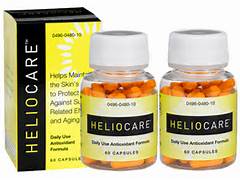

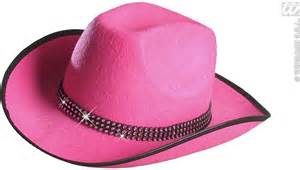
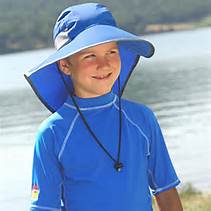
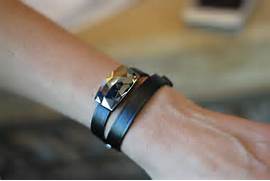
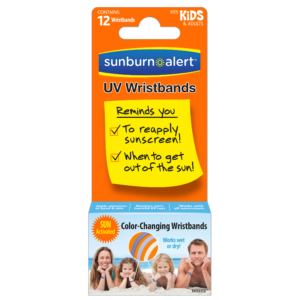


 D5 Creation
D5 Creation